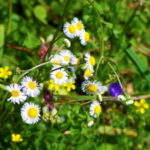Developed a strange rash? It could be one of these four common adult skin diseases.
Herpes Zoster or Shingles
When in my twenties, I once developed a blistering rash on one of my shoulders. The intense pain accompanying this rash surprised me. It was not the sort of chafing discomfort many rashes cause, but a deep tingling nerve pain. The school health clinic diagnosed this condition as shingles.
Shingles is an often painful skin condition that results from long dormant varicella zoster, aka chicken pox, virus flaring up. The initial symptoms, in what is called the prodromal stage, may include fever, headache, chills, and numbness, pain or itching on one side of the body or face. Two to 5 days later, a rash will appear, generally on one side of the body. During this eruptive stage, clusters of blisters filled with clear liquid whose appearance mimics chicken pox, appear, often accompanied by redness and swelling.
The prescribed treatment? Back then I was advised to wait for it to go away, something that could take 3-5 weeks. Today antivirals are commonly prescribed.
Years later, I described this experience to one of my aunts. She related her own experience with shingles, a bizarre experience for sure. She was having severe abdominal pain and was hospitalized repeatedly without the cause being found. This condition seemed to be progressing and becoming debilitative. Doctors were looking at the possibility of cancer. Eventually, during one of her hospitalizations, doctors found large pus capsules inside her abdominal cavity- and they told her she had shingles. The doctors removed the infectious material. After she recovered, she had no further flare-ups. The pain was gone, and she was able to resume her normal activities.
According to the National Institute of Neurological Disorders and Stroke, shingles is uncomfortable but not dangerous for healthy people. It is a serious threat to those who are immunosuppressed. If transmitted to persons who have never had chicken pox, it will result in a case of chicken pox. If shingles appears on the forehead or near the eye, it is important to have the shingles checked by a doctor. Untreated shingles that affects the eye can lead to vision loss.
Some common questions people ask about shingles, and their answers, include:
Is herpes zoster (shingles) related to the sexually transmitted disease herpes genitalis? No.
Is there a vaccine for shingles? The Zostavax vaccine was approved in 2006 for use in adults age 60 and older. Shingles is riskier for elderly than young people with the variety of ongoing health issues they commonly experience.
What is the risk of a repeat case of shingles developing? The estimated incidence of shingles in the United States of America is 600,000-1,000,000 cases. Approximately five percent of those are repeat cases.
Approximately 85% of people will develop an allergic reaction if exposed to poison ivy, the United States Food and Drug Administration (FDA) declares on its website, citing data from the American Academy of Dermatology.
The allergic reaction to poison ivy generally consists of a rash with raised blisters and intense itching. The cause is urushiol, a chemical in the plant. Two factors affect the degree of reaction: the individual’s sensitivity to urushiol and the extent of exposure. Areas where the skin is thinnest will suffer the most intense effects, since skin penetration is necessary for the allergic reaction to develop and thin skin is penetrated more easily.
Most often, poison ivy sufferers acquire the rash by coming into direct contact with a poison ivy plant. However, direct contact with a poison ivy plant is not the only way to develop a case of poison ivy. Urushiol can remain on clothing or gardening tools that have come in contact with it for long periods- there are stories of people getting a poison ivy rash from putting on clothing a year after the clothing came into contact with the plant.
People who suspect they have been exposed to poison ivy need to act quickly to prevent or minimize a rash. Experts advise cleaning any exposed area with isopropyl alcohol, then washing the skin with water, and finally taking a shower with soap. Soap should not be used before the initial cleanings with isopropyl alcohol and plain water because of the risk of the urushiol sticking to the soap and spreading the poison ivy.
In most cases, no treatment is prescribed for poison ivy rashes. The rashes and blisters will go away on their own in 2-3 weeks. In severe cases, where more than 30% of the body is affected, prescription oral corticosteroids may be prescribed. Over the counter topical corticosteroids may be used to help reduce itching and various over the counter remedies may help dry up the blisters, including baking soda, calamine, zinc oxide, oatmeal bathes and similar remedies.
Poison ivy removal requires special care. Not only is it important to avoid exposure during the removal process, it is also important to follow local regulations for disposing of this toxic plant. Under no circumstances should the poison ivy plant ever be burned; the resulting smoke creates a risk of severe lung irritations.
We live in an area where poison ivy is common. My family has experienced both ends of the poison ivy spectrum. My husband is severely affected by the merest exposure to poison ivy. He will develop massive rashes that last for weeks and itch incessantly. No treatment seems to help. I, on the other hand, react minimally to poison ivy. At most, I develop a small, mildly irritating rash that resolves within a week, with or without topical treatment.
Often when my husband has developed a case of poison ivy, it has appeared to spread over the course of several days. The experts say that this is merely an illusion; what is actually happening is that different body parts are reacting to the urushiol at a different rate. The rash does not actually spread. Instead, new rashes are developing at differential rates.
Actinic or Solar Keratosis
Actinic or solar keratosis (AK) is a precancerous, scaly patch or bump on the skin. These spots range from pinhead size to more than an inch in diameter and vary tremendously in coloration from pale to dark, pink, red, or tan. The scaling is dry and hornlike.
Actinic or solar keratosis is the most common form of precancer. Many times, several AK spots appear all at once. These spots may go away on their own if sun exposure is avoided for a few years.
Ten to 15% of the active solar keratosis (tender, inflamed) will progress to squamous cell carcinoma if left untreated
Treatment can usually be done in a physician’s office. Before treating AK, a physician will biopsy a speciment to test for malignancy. There are 5 common treatments: cryosurgery, chemical peeling, laser surgery, topical treatment, and photodynamic therapy. Which treatment is used depends on where the AK is located and how many lesions are being treated. Whatever treatment is used, almost all AK can be prevented from developing into cancer if treated early.
AK is common, occuring more often in areas with high ultraviolet radiation. At least 5 million people in the United States have had at least one AK lesion. The best way to avoid AK is to avoid prolonged exposure to sunlight. Fair skin and immunosuppression are risk factors for AK.
Cercarial Dermatitis or Swimmer’s Itch
Cercarial dermatitis or swimmer’s itch is caused by a water-dwelling larval parasite “cercaria” associated with aquatic or migrating birds. The parasite enters water through bird droppings; its larvae then grow first in snails and then move on to ducks or other birds. When the parasite moves from its snail home to find a duck home, it may mistakenly penetrate human skin. When it does, the human develops swimmer’s itch. The larvae cannot develop in a human and will soon die.
Cercarial dermatitis is usually mild and consists of a rash that itches for up to a week on all parts of the body that have been underwater. The symptoms include tingling, burning, itching and small pimples that develop within 12 hours of exposure. Sometimes these pimples progress into blisters.
No treatment is prescribed for cercarial dermatitis. Topical ointments such as corticosteroids, cool compresses, epsom salts or oatmeal baths may be used to alleviate discomfort.
Cercarial dermatitis is not contagious. Anyone who swims in fresh or salt water is at risk for acquiring this rash, particularly during summer months. Swimmer’s itch is known throughout the world by a variety of names including duckworms, rice paddy itch, clam diggers’ itch, sawah, kubure, and hoi con.
To minimize the risk of acquiring cercarial dermatitis, avoid swimming or wading in areas known to be infected with the larvae or in marshy areas inhabited by snails. Shower or dry off immediately after leaving the water.
Sources:
http://shinglespainreliefforpain.com/pain_relief_treatment.htm, http://www.medicinenet.com/shingles/article.htm#1whatis,
http://www.cdc.gov/ncidod/dpd/parasites/cercarialdermatitis/factsht_cercarialdermatitis.htm, http://www.aocd.org/skin/dermatologic_diseases/actinic_keratosis.html,
http://www.medscape.com/viewarticle/488415_9,
http://www.fda.gov/fdac/features/796_ivy.html, http://www.ninds.nih.gov/disorders/shingles/shingles.htm.




